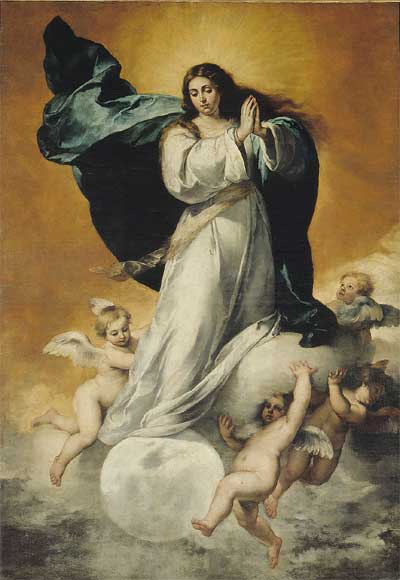
Teresa Monaghen, of Pro Sanctity and Fr. John Sianchuck, C.Ss.R., a Ukranian Byzantine priest do a great job of explaining the Western and Eastern understanding of this great mystery.
Take a listen to the discussion posted above, that Bruce and I had with Teresa Monaghen, from Pro Sanctity and Fr. John Sianchuk, C.Ss.R., a Ukrainian Redemptorist priest discuss the difference and similarities of Western and Eastern understanding of the Immaculate Conception of the Blessed Virgin Mary
[powerpress]
From the Catechism of the Catholic Church on the Immaculate Conception,Â
 “490 To become the mother of the Savior, Mary “was enriched by God with gifts appropriate to such a role.”132 The angel Gabriel at the moment of the annunciation salutes her as “full of grace”.133 In fact, in order for Mary to be able to give the free assent of her faith to the announcement of her vocation, it was necessary that she be wholly borne by God’s grace.
“490 To become the mother of the Savior, Mary “was enriched by God with gifts appropriate to such a role.”132 The angel Gabriel at the moment of the annunciation salutes her as “full of grace”.133 In fact, in order for Mary to be able to give the free assent of her faith to the announcement of her vocation, it was necessary that she be wholly borne by God’s grace.
491 Through the centuries the Church has become ever more aware that Mary, “full of grace” through God,134 was redeemed from the moment of her conception. That is what the dogma of the Immaculate Conception confesses, as Pope Pius IX proclaimed in 1854:
- The most Blessed Virgin Mary was, from the first moment of her conception, by a singular grace and privilege of almighty God and by virtue of the merits of Jesus Christ, Savior of the human race, preserved immune from all stain of original sin.135
 492 The “splendor of an entirely unique holiness” by which Mary is “enriched from the first instant of her conception” comes wholly from Christ: she is “redeemed, in a more exalted fashion, by reason of the merits of her Son”.136 The Father blessed Mary more than any other created person “in Christ with every spiritual blessing in the heavenly places” and chose her “in Christ before the foundation of the world, to be holy and blameless before him in love”.137
493 The Fathers of the Eastern tradition call the Mother of God “the All-Holy” (Panagia), and celebrate her as “free from any stain of sin, as though fashioned by the Holy Spirit and formed as a new creature”.138 By the grace of God Mary remained free of every personal sin her whole life long. ”
  This video does a nice job of tracking the history of the dogma
Tags: angel gabriel, ark of the covenant, blessed virgin mary, catechism of the catholic church, dogma of the immaculate conception, eastern tradition, immaculate conception, John Sianchuk, mary full of grace, mother of god, new ark, new creature, pope pius ix, sin, singular grace, teresa monaghen
This entry was posted on Monday, December 9th, 2013 at 12:08 am
You can follow any responses to this entry through the RSS 2.0 feed.
It’s a story of a young man named Giovanni, a pope named Pius IX and a time when….well I’ll let Omar Guiterrez tell the story...(he’s the best kind of “storyteller” because his stories are exciting, poignant, compelling and…true)
Guiterrez tell the story...(he’s the best kind of “storyteller” because his stories are exciting, poignant, compelling and…true)
An excerpt from Omar’s Regnum Novum post entitled “Giovanni and His Rome Beneath the Surface”:
It would behoove you to know that at this time in history, not too much unlike our own, the idea that the Catholic Church as we know it actually existed before the Middle Ages was an idea largely held to be ridiculous. Certainly there was a Christianity. But surely nothing like the Church of Rome. The scathing writing of the Enlightenment thinkers from the late 18th and throughout the 19th centuries had convinced most people that the priesthood, and much more so the papacy, was a Roman Catholic myth, invented to justify their inherently corrupting hold on power. Any notion from the average man that these existed before the stupefyingly dark ages of Medieval ignorance was mere pious idiocy. Even before this time, Martin Luther wrote, in his book titled Against the Roman Papacy Instituted by the Devil (catchy title no?),
I am content to be able to say, since I have seen it and heard it at Rome, that it is unknown where in the city the bodies of Saint Peter and Paul are located, or even whether they are there at all. Even the Pope and the cardinals know very well that they do not know.
Yet, in this world of legends and stories Giovanni lived in youthful and pious bliss. So it was that one fine Spring day in 1849, the same year that the Communist Manifesto was published, and at the ripe old age of 22, whilst the Roman birds sung their sweet songs of vernal joy to travelers on the ancient Appian road, Giovanni came across a piece of marble, which looked something very much like this:
Pieces of marble were constantly being found by farmers in the area. It is just a part of living in that world where history grows from the ground like the leaves of the acanthus plant that decorates the Mediterranean. This marble was probably dug up by the farmer attempting to ready his field for planting, and he tossed it toward the road. As fate – or should I say God’s good grace – would have it Giovanni, with all his peculiar knowledge, came across it on this day and at this hour. He examined the thing and began to wonder, as only a youthful lad can and does.
He recalled from his vast reading the legend of a Pope Cornelius who had been sentenced to exile by the new emperor Gallus. The emperor was a useless fellow, who had been put into power by the Roman army after the death of the Christian-hating Decius only to be killed by that same army two years later. Poor Pope Cornelius died in exile but was referred to in the martyrologies as not just a confessor but as a martyr. Furthermore, this Pope Cornelius, who reigned as the vicar of Christ from 251-253 was said to have been brought back to Rome and buried in the legendary Crypt of the Popes in the catacomb of St. Callistus. So perhaps, thought the youthful Italian lad, perhaps this is a marker for Pope Cornelius’ grave, which would mean that he’s buried in that field somewhere, which would mean that underneath lies not just the mythic Crypt of the Popes but also the original burial place of St. Cecilia, who was later moved to the Church in Trastevere that still bears her name, and all sorts of wonders within the famed – but never discovered – catacomb of St. Callistus. Yes, this was the reasoning of young Giovanni. This was the thought process of a young lad who had not lived long enough to know that silly dreams of an ancient Church were passé and never mentioned in polite company. These were the musings of a boy who dreamed to discover something true in an age of cynical doubting. And these were the notions that Giovanni Battista de Rossi took to Pope Pius IX.
To hear the whole story take a listen, and then visit Regnum Novum for the complete text and images…it’s get’s better…it’s SO touching and compelling…and it’s true
Tags: catholic, catholic podcast, catholic prayer, cathollc spirituality, Giovanni Battista Carlo de Rossi, papacy, pope pius ix, rome beneath the surface
This entry was posted on Monday, January 10th, 2011 at 3:26 am
You can follow any responses to this entry through the RSS 2.0 feed.

